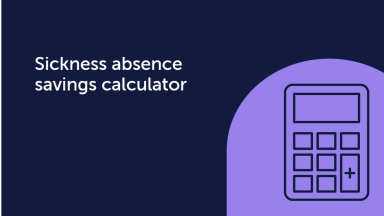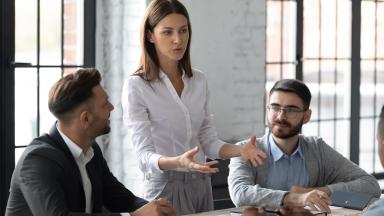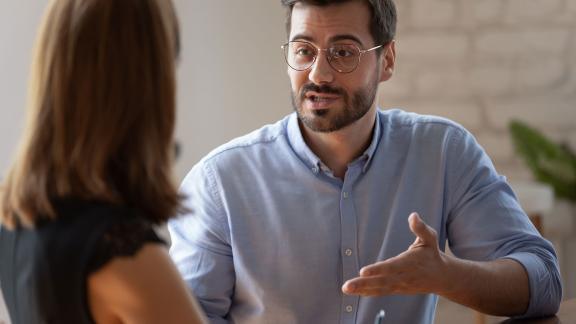About this toolkit
Welcome to our toolkit on proactively and supportively managing sickness absence.
This resource is designed to help NHS line managers take a consistent, confident and wellbeing centred approach to managing sickness absence.
It guides users through every stage, from prevention to responding when someone calls in sick to supporting their return to work or leaving the organisation. The toolkit emphasises early intervention, compassionate support and the importance of creating a positive environment that promotes staff health and prevents avoidable absence. This is especially important given that data from the NHS Staff Survey 2024 reinforces that compassionate and inclusive leadership is a key enabler of staff engagement, the strongest predictor of care quality, innovation and patient outcomes.
Embedding prevention in sickness absence
The NHS Long Term Plan sets a clear direction: shift the focus from reacting to illness to preventing it by supporting staff wellbeing every day. A preventative approach to sickness absence means creating the conditions where staff can stay well and thrive, not just stepping in when they’re already struggling.
Embedding wellbeing starts with key foundations, ensuring NHS staff have access to rest, hydration, and psychologically safe environments. As outlined in supporting the wellbeing needs of NHS staff, these foundational needs are critical to creating a healthy workplace. It also means fostering open health and wellbeing conversations and creating personalised wellbeing plans. These simple, everyday actions can significantly reduce avoidable absence, boost morale, and enhance performance.
Wellbeing support should reflect the diverse experiences of NHS staff. Everyone’s needs are different, shaped by factors like race, gender, disability, age, sexuality and caring responsibilities and neurodiversity.
Inclusive approaches that recognise this diversity, such as adjustments for neurodivergent colleagues (like quiet spaces, flexible working and clear communication), can make a real difference in preventing stress and burnout. It’s also important to remember that wider factors like social and economic circumstances can affect someone’s health and wellbeing outlook. Managers aren’t expected to have all the answers and support is available through HR, occupational health and staff networks to help navigate these situations with compassion and confidence help build stronger, more resilient teams.
Presenteeism and coming to work while unwell, can have a huge impact on an individual's productivity, their mental health and be just as disruptive as absence. Managers play a vital role in spotting the signs, encouraging recovery and modelling healthy behaviours. When rest and recovery are treated as essential, not optional, it sends a powerful message: your wellbeing matters. To do this well, managers need the right support themselves. Accessing training and development opportunities helps line managers to feel confident in having wellbeing conversations, recognising early warning signs and creating psychologically safe environments.
Research shows that organisations investing in line manager training are more likely to adopt holistic approaches to wellbeing, including preventative and responsive strategies. Investing in your managers capability is a key part of embedding prevention into everyday practice. This aligns with the expectations of line managers in relation to people management, which outlines the vital role managers play in supporting staff wellbeing and fostering inclusive, compassionate workplaces.
Empowering staff to set and maintain healthy boundaries is another key part of prevention. When managers support staff to say no when needed, whether it’s to overtime, emotionally demanding tasks, or skipping breaks, it builds trust and psychological safety. Freedom to speak up guardians also help embed this culture, offering a safe space for staff to raise concerns and feel heard.
To embed wellbeing into everyday practice, NHS organisations can:
-
review current wellbeing practices, identify gaps and use the NHS health and wellbeing framework to guide improvements.
-
use tools like a health and wellbeing passport and personalised wellbeing plans
-
create space for open, inclusive conversations about what wellbeing means to staff
-
create space for open, inclusive conversations about what wellbeing means to staff
-
support access to rest and recovery without stigma
-
commit to continuous improvement, recognising that wellbeing is a journey, not a tick-box.
By embedding these principles into daily management practice, NHS organisations can prevent sickness absence, improve staff experience and deliver safer, more compassionate care.
Working in partnership with trade unions is an important part of supporting staff through sickness absence. It helps ensure fairness, transparency and that agreed policies are followed. When reviewing or updating sickness absence policies, involve trade union representatives early. Their insight can help shape best practice and give staff confidence that their voices are heard. Trade unions also play a key role in promoting inclusive wellbeing approaches, making sure preventative measures and personalised support plans meet the needs of all colleagues.
When staff report they are sick
The response when a colleague calls in sick significantly affects how supported they feel, which in turn impacts their feelings about returning to work.
Communicate your reporting practices
Clear and well-communicated reporting procedures help managers respond effectively when a team member calls in sick. They ensure the right information is gathered to keep things running smoothly, address any future concerns and most importantly, support the employee during their absence. Managers should ensure their teams know how to report sickness, where to find the reporting procedure and who to contact. This helps avoid misunderstandings and ensures timely, supportive communication.
It’s also important that managers are familiar with the reporting process themselves, including who is responsible for reporting and where to find contact details for occupational health, counselling services, employee assistance programmes (EAP), and Rapid access services. Being prepared allows managers to respond with empathy and offer the right support when it’s needed most.
Regularly discuss the reporting procedure during staff briefings. This helps staff understand and contribute to its effectiveness. It also emphasises that absence reporting prioritises staff health and wellbeing, ensuring the team feels supported.
Gather key information effectively
When a team member reports sickness, it’s important for managers to respond with empathy while gathering the information needed to support the individual and maintain continuity at work. Managers should always ask:
- What’s the reason for the absence?
- Do you have a sense yet of how long you might need to be away?
- Is there any work that needs to be supported whilst you're away?
Your organisation’s sickness absence policy may include additional questions to guide these conversations.
It’s also important to remember that sickness absence information is confidential. Managers should avoid sharing details with the wider team unless the employee has given clear consent. A simple question, such as, “Would you like this to be kept confidential, or are you happy for me to share anything with the team?” can help avoid misunderstandings and support trust.
Managers may also want to explore:
-
Is there anything you can do to help them feel well enough to return to work in a way that feels manageable?
-
Are there any adjustments possible that could ease their transition back into work?
-
If the illness is infectious, how long should they stay off once symptom-free?
-
If it’s a musculoskeletal (MSK) issue, can they be referred to a rapid access service within your organisation or integrated care system (ICS)?
-
If it’s related to mental health, is a referral to a counselling or mental health hub appropriate?
-
If they are fit to work but unable to attend in person, can they work remotely or from another location?
-
If the absence may last several days, when will they next provide an update, and are there any steps they’re taking that the manager should be aware of?
-
Can you agree a plan for how often to maintain contact to support their wellbeing?
It is the responsibility of line managers to maintain accurate records of sickness absences. This includes noting the reason for absence, documenting conversations with the employee while they are off and recording any meetings held after their return. These records help ensure continuity, support and fairness in how absences are managed.
Over time, well-kept records can reveal patterns or themes in absences, allowing managers to offer timely and appropriate support. This enables fact-based, compassionate conversations and early interventions, such as referring someone with back pain to physiotherapy before it becomes a recurring issue. Thoughtful record-keeping helps prevent small health concerns from becoming long-term problems.
Listen and support
Active listening is a vital part of any conversation when a team member calls in sick. While it may seem obvious, it’s easy to overlook, especially when managers are juggling competing demands. Taking a moment to imagine how it would feel to be the one making that call can help managers respond with empathy. What would they want to hear from their own manager? How would they want to be supported?
Sometimes, the most helpful response is simply to listen, wish the employee well and agree on when to check in next. By listening carefully, reserving judgment, offering referrals to further support if needed, and allowing space for the employee to talk things through, managers can ensure their team members feel genuinely supported and valued.
Sickness absence coding
Sickness absence codes are important in identifying trends and targeting appropriate interventions, such as infection prevention measures or stress management support. Accurate coding also allows organisations to compare their sickness absence rates with national benchmarks and gain insights into overall performance.
Line managers are responsible for recording sickness absence accurately, including the duration and relevant ESR codes. These codes can be found within the ESR system, usually under the absence recording section. If you're unsure which code to use, your HR team or ESR lead can provide guidance. Many organisations also provide quick-reference guides or access to the ESR hub for support on accurate recording. Accurate coding helps identify patterns, address underlying issues, and ensure employees receive the correct sick pay and support. If an employee is reluctant to share the reason for their absence, managers can suggest they speak with HR, occupational health, or a trusted colleague. Alternatively, showing the list of codes and inviting the employee to choose the most appropriate one can help. Accurate coding ensures timely support and enables effective interventions that promote wellbeing across the team.
Stay in touch
If an employee is likely to be off for more than a day, the manager needs to agree on how often they’ll stay in touch and who will initiate the communication. Setting clear expectations around contact can offer reassurance and help maintain a supportive connection.
Regular check-ins allow for
reviewing available organisational support
planning workload coverage to maintain service continuity
discussing return-to-work dates and options
setting clear communication expectations
being empathetic and flexible to individual needs
documenting conversations appropriately.
Most employees will return to their usual role and work environment, but sometimes adjustments are needed to support their return and prevent further absences. Discussing these adjustments early gives managers time to arrange the necessary support, equipment, or changes. This proactive approach can help employees return to work sooner and feel more confident doing so. For further guidance, managers can refer to resources, such as making reasonable adjustments to support disabled staff in their roles.
Short term sickness
Managers play a key role in recognising patterns in absence history and offering timely, compassionate support. Early action helps staff feel supported, addressing underlying issues and contributing to a healthier, more resilient workplace.
Long-term sickness absence
Understanding long-term sickness absence
Long-term sickness absence is defined as a continuous period of absence lasting more than 28 days.
Employees are required to provide a fit note from their GP if they are absent for more than seven consecutive days, including non-working days. A fee may apply if a fit note is requested before seven days. The fit note is a statement of fitness to work (or Med 3 form) that was introduced in 2010.
The fit note is advice from a healthcare professional to help the employee and employer discuss ways to support an employee to stay in work or return to work. If the fit note suggests the employee ‘may be fit for work,’ the line manager should initiate a supportive conversation to explore possible adjustments, such as regular wellbeing conversation, flexible working, amended hours or modified duties that could enable a safe and sustainable return. Advice and guidance on reasonable adjustments should be sought from occupational health and, where appropriate, relevant charities or support organisations.
Managing long-term absence
-
Ensure the employee provides a fit note from their GP and forward it to payroll promptly.
-
Agree on a regular and comfortable pattern of contact, considering their preference and wellbeing.
-
Reassign tasks within the team, consider longer term cover options if funding allows which could include the use of bank staff or consider temporary recruitment to maintain service delivery.
-
Familiarise yourself with your organisation's long-term absence policies and seek guidance from HR when needed.
-
Ask the employee if they are happy to share more about their health condition so you can understand how this impacts and start to consider potential adjustments. The employee will know best how this is impacting them. Reach out to OH, charities, or support organisations for advice and resources.
-
Begin early conversations about returning to work. Explore reasonable adjustments and alternative roles if needed.
-
Work closely with HR and occupational health throughout the process to ensure consistent and compassionate support. Sometimes joint meetings can be helpful.
-
Be aware of policies around redeployment, ill-health retirement, or other pathways and approach these discussions with sensitivity and respect.
Line managers should be familiar with their organisation’s long-term absence policies to provide informed and supportive guidance.
Stay connected
Maintaining regular contact with a colleague during long-term absence is essential. This connection helps the employee feel supported and keeps the manager informed of their progress.
At the outset, the manager and employee should agree on how and when communication will take place, including how updates on treatment and recovery will be shared. Regular contact enables the manager to provide appropriate support and plan effectively for the employee’s return to work.
Managers should remain aware of key milestones in the employee’s recovery, such as GP reviews or hospital appointments. The shared aim is to support a safe and positive return to work, with the employee feeling involved and informed throughout the process.
Manage their workload
Depending on the length of absence, managers should consider whether the team can reasonably absorb the colleague’s workload or if additional support is needed. This decision should balance the wellbeing of the team with the need to maintain service quality and patient care.
Consider the following when managing their workload
-
Understand the likely duration of the absence. Short-term absences may be manageable within the team, while longer-term absences might require additional support.
-
Identify tasks and responsibilities that need to be covered. Consider their complexity and who is best placed to take them on.
-
Assess the team’s capacity to take on extra work without affecting their own wellbeing or performance.
-
For longer absences or heavier workloads, explore options such as temporary staff or bank cover to maintain service continuity and protect team wellbeing.
-
Managers should be familiar with organisational policies on managing absence and seek guidance from HR and occupational health as needed.
-
Explore flexible solutions such as adjusting roles, job sharing, flexible hours, or temporary changes in responsibility.
-
Communicate clearly and supportively with the team about any changes. Open, regular communication helps maintain morale and trust.
-
Monitor workload distribution regularly to ensure fairness, prevent burnout and maintain a healthy work environment.
Proactively support the absence
To effectively support an employee during long-term sickness absence, managers should stay informed about the next steps in their recovery, even if it's an upcoming appointment. This helps maintain continuity of care and ensures the employee feels supported throughout their absence.
Many organisations are taking a more proactive approach to supporting staff during sickness absence, focusing on wellbeing and collaboration rather than just process. This means working together, between HR, occupational health, the line manager, the employee and, where appropriate, medical professionals and staff representatives. It’s important to make sure colleagues feel supported throughout their absence. Inviting a trade union representative to case review meetings and return to work planning discussions can help achieve this. Their involvement ensures staff have someone advocating for them and that conversations remain fair, transparent and focused on finding the best way forward. Such joined-up working ensures the employee receives consistent and compassionate support.
Early in the process, it’s helpful to designate a case manager to coordinate communication, reduce delays, and streamline access to support services and appointments.
The key to effectively managing long-term sickness absence is to always know the next step for your employee.
Planned absence
When an employee has a planned absence, such as surgery or treatment, start with an open and honest conversation. Agree together on how and when you’ll stay in touch, confirm any adjustments they might need before the absence begins and discuss a return-to-work plan in advance. Taking these steps early can ease any anxiety and reassures your colleague that they’ll be supported throughout. Where it’s helpful, involve HR and occupational health so any workplace adjustments or phased return options are ready ahead of time.
Managing extended absence
If an employee’s absence extends beyond 28 days, the line manager should arrange a meeting to review the situation and explore supportive next steps. The aim is to have a positive, open conversation about the nature of the absence and discuss options for returning to work or continuing the absence with appropriate support. In cases where the absence may be work-related, or where there are concerns about management or workplace factors, it may be appropriate to involve a separate welfare support contact.
It should be made clear to the employee that this meeting is not part of any disciplinary process. Instead, it is an opportunity to listen, understand any concerns affecting their attendance and discuss ideas that may help facilitate a return to work.
If returning to work is not currently possible, the manager should consult with HR and occupational health, referring to relevant policies. Employees should also be encouraged to seek support from staff representatives where appropriate.
A compassionate and collaborative approach helps ensure the employee feels supported and involved in decisions about their future at work.
Reasons for absence
In this section, we look at some of the reasons that might be given for sickness absence in the NHS.
Supporting staff off sick
Maintain contact
Regular, positive contact helps employees feel supported and reduces isolation. Managers should speak with the employee early to understand the nature and expected duration of the absence.
For longer absences, weekly check-ins are recommended, but frequency should be agreed with the employee. Each conversation should allow time to discuss wellbeing, support needs, and potential return-to-work options, including phased or adjusted duties.
Keeping employees informed about workplace updates and including them in relevant communications can ease concerns and support reintegration.
Managers should follow organisational policies on sickness absence and ensure staff understand reporting procedures. Involving employees in shaping these processes can improve confidence and engagement.
Case management approach
For extended sickness absence, an active case management approach can help coordinate support and reduce delays. This involves collaboration between the line manager, HR, OH, the employee, and, where appropriate, medical professionals.
Ideally, this approach begins early in the absence. One person should lead the case, ensuring communication is streamlined and appointments or decisions aren’t unnecessarily delayed.
Things to consider
How is the employee doing and are they making progress?
Are they receiving appropriate support and treatment?
Are they waiting for services like physiotherapy, counselling or outpatient care?
Which aspects of their role are currently difficult or not possible?
When might they feel ready to return to work?
Could minimal or adjusted duties support their return?
What support can be offered? For example: facilitating access to treatment for services, adjusting hours or responsibilities or exploring temporary alternative roles.
Rapid access to treatment
Rapid access (or fast-tracking) enables NHS staff to receive timely rehabilitation and treatment without impacting patient care. This approach supports quicker, practical, and reasonable returns to work, tailored to individual and organisational needs. Where support is complex, it should also demonstrate value for money.
Early intervention, such as physiotherapy, counselling, or occupational therapy can prevent conditions from becoming chronic and improve recovery outcomes. Evidence shows that acting early in a sickness absence period is more effective than waiting for formal review triggers.
For example, referring an employee to physiotherapy in the first week of absence may enable their return before a standard case review would typically occur, benefiting the employee, the organisation and patient care.
The updated guidance on rapid access to treatment and rehabilitation for NHS staff supports NHS organisations in managing staff access to timely care.
A case study from Cambridgeshire and Peterborough NHS Foundation Trust highlights how a rapid-access mental health service was successfully developed for staff.
Implementing a rapid access scheme can lead to significant organisational, savings, support a healthy and more consistent workforce and ease pressure on colleagues covering sickness absence.
Fit note and sick note
From 1 July 2022, legislation across England, Wales, and Scotland allows registered nurses, occupational therapists, pharmacists and physiotherapists to legally certify and issue fit notes, alongside doctors.
Employers should be aware that:
fit notes can now be issued digitally without a physical signature
employees can return to work before a fit note expires
fit notes are advisory; employers may seek additional evidence if needed.
For full guidance, visit the GOV.UK fit note guidance page.
Fit notes provide general advice on an employee’s fitness for work, not just their current role, giving managers flexibility to explore adjustments that could support a return to work.
Managers should receive a copy of the fit note promptly to understand the reason for absence, identify support needs and begin planning a return-to-work approach. Fit notes may indicate whether a new one is likely to be needed when the current one expires.
If an employee does not provide a fit note confirming they are unfit for work, this may be considered unauthorised absence. Managers should seek guidance from HR in such cases.
When a fit note states the employee may be fit for work, it suggests that returning could aid recovery. The note may include recommendations such as phased return, altered hours, amended duties, or workplace adaptations. Managers should work with occupational health to assess and implement these adjustments.
Healthcare professionals issuing fit notes may not be familiar with the employee’s specific job or environment. Occupational health can help interpret the advice and suggest suitable alternatives. Consent from the employee is required before contacting their GP or other medical professionals.
For detailed guidance on using fit notes effectively, see the official government resource:
Getting the most out of the fit note – Guidance for employers and line managers.
Using your occupational health service
Occupational health (OH) supports staff wellbeing by assessing fitness for work and advising on how work may affect health. OH can guide managers on reasonable adjustments to help employees stay in or return to work.
Managers should focus on how health impacts the employee’s ability to perform their role, rather than the medical details. It’s important to explain the reason for any OH referral to the employee and provide them with a copy of the referral letter.
Confidentiality rules limit the sharing of personal medical information. Managers should consult HR for advice on local referral procedures.
NHS England’s Growing occupational health and wellbeing together strategy aims to strengthen OH services across the NHS, supporting staff to stay healthy and deliver high-quality care.
Managers are encouraged to contact their OH department for advice on supporting staff and identifying any reasonable adjustments that could help an employee return to work.
Managers are encouraged to contact their OH department for advice on supporting staff and identifying any reasonable adjustments that could help an employee return to work.
Impact on the team
Before speaking to your employee, take a moment to consider any practical updates that may help with planning during their absence, such as ongoing work or meetings that may need cover. Keep the focus on support and understanding, especially if the absence may be related to workplace stress.
Have a plan for how their work will be managed or re-prioritised during their absence. Sharing this with the employee can help ease any worries about workload and reassure them that things are being taken care of, allowing them to focus on recovery.
Things to consider
Ask how they’d like you to communicate their absence to the team or wider organisation. Some people prefer to keep things private.
If they do want privacy, agree on what you’ll say to the wider team, something simple like, “X is off this week and hoping to be back next week. I’ll keep you updated.”
Be clear, positive and supportive with both your employee and the team. Focus on what needs to be done and how you’ll manage it, rather than the absence itself.
Put a plan in place to make sure services run smoothly and the team isn’t overwhelmed. That might mean shifting priorities or redistributing tasks.
Make sure you know what support is available for your team, such as counselling, wellbeing programmes, or EAPs. HR and OH can help with this.
When someone on your team is off sick, it's important to have a conversation with them early. You’ll need to think about how their absence affects the rest of the team. One helpful step is ensuring team members are familiar with each other’s roles, so things can keep running smoothly. Having a contingency plan in place, especially for longer-term absences, can really help everyone feel more prepared and involved.
Keep your door open. Be clear, positive and supportive when talking to both the person who’s off and the rest of the team. This helps reduce gossip and keeps morale up.
If the workload increases, acknowledge it. People might feel stretched or frustrated, so lead by example, stay supportive, keep everyone informed and thank them for their efforts.
Respect your employee’s privacy. If they don’t want others to know details about their illness, that’s okay. Just make sure the service continues to run smoothly and if you’re unsure what to share, check in with HR.
Sometimes, well-meaning messages can feel overwhelming. Ask your employee how they’d like to handle this and agree on a plan together.
Finally, make sure your team knows what support is available, like counselling or Employee Assistance Programmes (EAPs). If you’re unsure, HR or OH.
Your employee might not want their colleagues to know about their illness, so it’s important to check with them first and respect their privacy.
Return to work
Reasonable adjustments and legal responsibilities
Reasonable adjustments can support employees to stay in work or return after sickness absence. These should be explored early and collaboratively between the employee, their manager, HR, and OH.
It’s also important to recognise that adjusting to a new diagnosis of a disability can be emotionally and practically challenging. This period of adjustment may significantly affect an employee’s readiness to return to work and compassionate, flexible support is essential.
Schemes such as Access to Work scheme, a government funded programme, provide practical and financial support to help people with physical or mental health conditions or disabilities stay in or return to work. It covers additional employment costs that go beyond the reasonable adjustments employers are legally required to make under the Equality Act 2010. Support can include specialist equipment, travel assistance, or personal support, and is available for any paid role, regardless of hours or contract type. This factsheet provides managers with information on how Access to Work can offer practical and financial support to staff facing barriers due to disability or long-term physical or mental health conditions.
NHS England Health and care passport is another useful tool that enables staff to document and share their support needs, preferences, and adjustments in a consistent way. It can help facilitate conversations between employees and managers, ensuring that support is personalised and clearly understood.
Under the Equality Act 2010, employers must consider reasonable adjustments for staff whose health condition, injury, or impairment meets the criteria for disability. If an employee cannot continue in their role even with adjustments, employers are legally required to consider redeployment to a suitable alternative role. If no such role exists and all options have been exhausted, termination may be lawful, but this is not considered redundancy under the Act.
Some NHS trusts also have disability leave policies, which offer paid leave for disability-related appointments or recovery. Where these policies exist, managers should explore them as part of the support available.
Seeking advice from HR and OH is essential when planning adjustments or changes to duties. A risk assessment may be needed to ensure any modifications are safe and appropriate. Even where the Equality Act does not apply, offering adjustments is considered best practice and supports a fair and inclusive workplace.
Health and safety
Health and safety aims to minimise illness and injury in the workplace. It covers policies, accident reporting, hazard identification, risk assessments, manual handling, violence towards staff, infection control and needle stick injuries. All staff share responsibility for maintaining a safe working environment.
Managers have a duty of care to ensure policies and procedures are followed. The NHS Injury Allowance guidance outlines support available for staff affected by work-related injury or illness. Managers should be familiar with local health and safety policies, which vary by business area, for example, guidance for freight and logistics differs from office-based environments. Support is available through OH or HR departments.
Managers are responsible for conducting risk assessments and implementing preventative measures. Support with training for both managers and staff can be provided by your health and safety team, OH or HR departments to help maintain a safe working environment.
Managers need to connect with their organisations health and safety team to understand their responsibilities in maintaining a safe environment for staff, colleagues, and patients. The Health and Safety Executive (HSE) offers tools such as the line manager competency indicator tool to help assess skills and identify training needs.
The NHS Staff Council’s Health, Safety and Wellbeing Group (HSWG) provides Workplace health and safety standards to help organisations meet legal requirements and adopt best practices. Their guidance covers areas like lone workers, sickness absence, and Musculoskeletal health in the workplace, with practical measures to reduce work-related injuries.
Health and safety in the NHS in England is regulated by the Health and Safety Executive (HSE) and the Care Quality Commission (CQC), which coordinates efforts and shares information. The HSE also collaborates with regulators like the General Medical Council (GMC) and offers extensive online resources, including safety alerts for employers.
Managers hold a duty of care to their teams, ensuring that policies and procedures are followed.
Return to work meeting and plan
Return-to-work meetings are one of the most effective ways to reduce short-term sickness absence. It reassures employees that their presence matters, that they were genuinely valued during their time away and that their wellbeing continues to be important.
These meetings should happen after every sickness absence, even if it’s just one day. Frequent short absences can sometimes signal underlying health issues, so it’s important not to overlook them.
What to cover:
-
welcome the employee back and ask how they’re doing
-
confirm the reason for their absence
-
check if they’re fit to return and if any support is needed
-
reassure them they were missed and valued
-
keep the tone supportive, fair and consistent.
Most organisations provide a template to guide the conversation and record any agreed actions. Always follow your local policy and procedures when conducting the meeting.
A well-managed return-to-work plan helps employees reintegrate smoothly and supports their recovery. Plans should be reviewed regularly and adjusted if needed. Share lessons learned with HR, OH, and other managers to improve future support.
Planning the return
-
confirm return date and any prep needed (equipment, duties)
-
outline any therapeutic or phased return arrangements
-
set review dates and identify who’s involved
-
note any impact on pay or terms
-
record reasonable adjustments and review timelines
-
use ESR codes accurately and seek HR/OH guidance if unsure.
Redeployment
Sometimes, an employee can’t return to their original role straight away, especially if their illness or injury makes certain duties unsuitable. In these cases, redeployment can be a helpful short or long-term solution.
Redeployment allows staff to take on a different role while they recover, or permanently if they’re unable to return to their previous job. It’s a valuable way to retain skilled NHS staff and reduce the need for redundancy.
Check your local redeployment policy for full details and explore our resource on the impact of redeployment on nurse wellbeing and retention for further insights and recommendations.
Risk assessments
Risk assessments help identify and manage potential hazards in the workplace. It’s the employer’s responsibility to carry them out, and managers should regularly review and update them with input from their teams.
Operational managers usually lead this in their areas, with support from health and safety advisors if needed. Staff input is valuable, especially for job-specific risks. Familiarise yourself with your local policy to ensure you are implementing any required steps.
Five simple steps
Identify hazards.
Decide who might be harmed and how.
Evaluate risks and decide on precautions.
Record findings and take action.
Review and update regularly.
You may find it useful to visit the Health and Safety Executive’s website, which contains a range of resources on risk management. This includes a risk assessment and policy template along with frequently asked questions.
Further information
Resources
Union and partnership resources
Contact
For further information or if you want to get in touch, please contact the NHS Employers health and wellbeing team.









